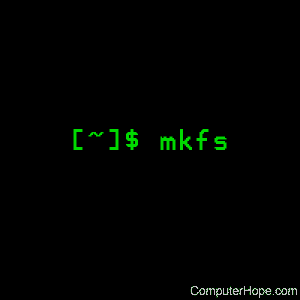Linux mkfs command

On Unix-like operating systems, the mkfs command creates and builds a file system.
This page describes the Linux version of mkfs.
Description
mkfs is used to build a Linux file system on a device, usually a hard disk partition. The device argument is either the device name (e.g., /dev/hda1, /dev/sdb2), or a regular file containing the file system. The size argument is the number of blocks to be used for the file system.
The exit status returned by mkfs is 0 on success and 1 on failure.
In actuality, mkfs is a front-end for the various file system builders (mkfs.fstype) available under Linux. The filesystem-specific builder is searched for in many directories, like perhaps /sbin, /sbin/fs, /sbin/fs.d, /etc/fs, /etc (the precise list is defined at compile time, but at least contains /sbin and /sbin/fs), and finally in the directories listed in the PATH environment variable. Please see your filesystem-specific builder manual pages for further details.
Syntax
mkfs [options] [-t type fs-options] device [size]
Options
| -t, --type type | Specify the type of file system to be built. If not specified, the default file system type (currently ext2) is used. |
| fs-options | Filesystem-specific options to be passed to the real file system builder. Although not guaranteed, the following options are supported by most file system builders. |
| -V, --verbose | Produce verbose output, including all filesystem-specific commands that are executed. Specifying this option more than once inhibits execution of any filesystem-specific commands. This is really only useful for testing. |
| -V, --version | Display version information and exit. Option -V displays version information only when it is the only parameter, otherwise it works as --verbose. |
| -h, --help | Display help and exit. |
Examples
mkfs -t ext2 /dev/fd0
The example above would create an ext2 file system on a floppy diskette in the first floppy drive.
Related commands
fdisk — A disk partitioning utility.
fsck — Check and repair a Linux file system.
losetup — Set up and control loop devices.
